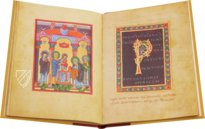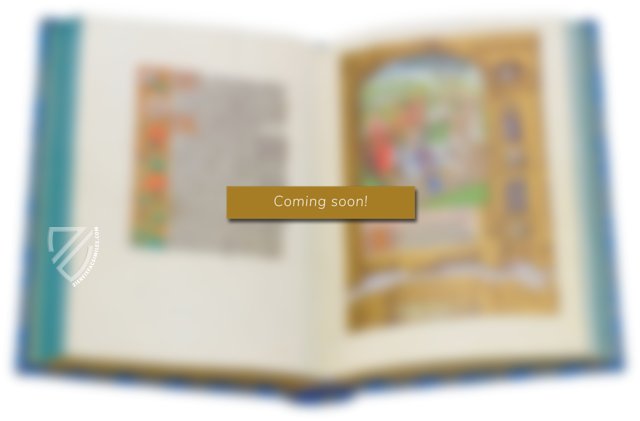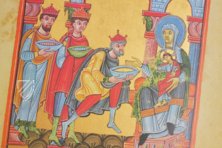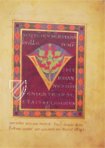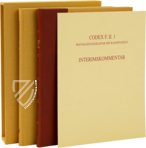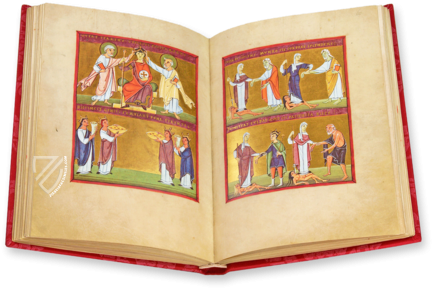Gospel Harmony of Eusebius
(under 1,000€)
The Reichenau school of book illumination was one of the most important centers of manuscript production during the Middle Ages and greatly influenced and in many ways shaped the style of Ottonian book art. The so called Gospel Harmony of Eusebius is a wonderful evangelistary and a prime example of the late phase of Reichenau book illumination. The 19 ornate canon tables, each unique with respect to its design, are followed by Gospel pericopes featuring magnificent miniatures depicting the various works and events in the life of Jesus Christ. The monumental illumination is characterized by classical-appearing architecture, gleaming gold backgrounds, bright colors and expressive, static figures. The 11 full-page miniatures are accompanied by opulently framed incipit pages with beautiful golden initials with scroll ornaments and precious silver lettering on a purple background, giving the manuscript a truly solemn and royal splendor.
Gospel Harmony of Eusebius
Among the irreplaceable masterpieces of the school of Reichenau is the manuscript Queriniana in Brescia, composed almost exclusively of full-page miniatures, initials and elaborate canon tables. The codex is introduced by 19 leaves, portraying 19 architectural, artfully executed canon arches that frame the Gospel Harmony created by Eusebius in the 4th century. For centuries, this late antique work served as a quick and systematic tool for finding corresponding biblical passages. The canon tables of this Splendid manuscript are ornate with a variety of luxurious decorations and none of the many colorful columns are identical; architectural gables and arches, inspired by the classical style, alternate to form a perfectly harmonious composition. Little is known about the origins of the manuscript. By the 14th century at the latest, the codex was in the possession of the upper Italian Lamberti Family, whose coat of arms adorns the very first page of the manuscript. The question today is whether its current contents were assembled from two manuscripts, and might be answered by future research.
Gorgeous Ottonian Illumination
This first section is followed by the Gospel Pericopes and includes eleven full-page miniatures as well as twelve luxury initials facing each other and introducing the readings for the different feast days. The solemn character of the book is further underlined by a number of initials set on purple ground and preceding the individual readings. The vivid orange fillings further enhance the colorfulness so typical of Ottonian illumination from Reichenau. This unique manuscript is rarely mentioned in the expert literature, perhaps because of its remote repository, but whoever does so, describes it with the greatest esteem. Its 42 miniatures and initials, all executed in glittering gold, are among the finest examples ever created by artists of the Ottonian period. The monumental feast day Gospels document the beauty and quality of Reichenau book illumination in its heyday.
Codicology
- Alternative Titles
- Evangelienharmonie des Eusebius
Festtagsevangelistar mit Kanontafeln
Le concordanze di Eusebio
Eusebio di Cesarea
Concordantiae Evangelicae of Eusebius Caesariensis - Size / Format
- 84 pages / 35.0 × 25.0 cm
- Origin
- Germany
- Date
- Second quarter of the 11th century
- Epochs
- Style
- Genre
- Language
- Script
- Carolingian minuscule Square capitals Uncial
- Illustrations
- 19 canon-tables, 11 full-page miniatures, and 12 full-page initials with rich gold ornaments
- Content
- Eusebius' canon tables followed by a Gospel Pericopes
Gospel Harmony of Eusebius
Harrowing of Hell
Between the Crucifixion and the Resurrection, Christ descended into Hell to proclaim good tidings to the dead and bring salvation to all the righteous who have died since the beginning of the world. In front of a timeless and spaceless golden background, Christ stands in a blue mandorla upheld by angels. He holds a scroll in his left hand while reaching out with his right and takes the hand of one of the denizens of Hell to pull them up from the flames and take them to Heaven.

Gospel Harmony of Eusebius
Baptism of Jesus
This miniature page is a splendid example of the Reichenau school of illumination and of the Ottonian style in general. At the same time, the influences of Byzantine illumination are obvious: a magnificently polished background, grand aesthetic, exaggerated gestures, flat facial features with piercing eyes, and strong symbolism.
As the Holy Spirit descends from above in the form of a bird, Christ is depicted rising from the River Jordan with the assistance of John the Baptist and gives the sign of benediction. Two of his disciples wait to dry him off on the right bank. The gold background gives the scene a feeling of the divine, as though it was lifted out of time and space for a moment because of the gravity of this event in the Vita Christi.

#1 Die Evangelienharmonie des Eusebius
Languages: English, German
(under 1,000€)
#2 Le concordanze di Eusebio
Language: Italian
(under 1,000€)
- Treatises / Secular Books
- Apocalypses / Beatus
- Astronomy / Astrology
- Bestiaries
- Bibles / Gospels
- Chronicles / History / Law
- Geography / Maps
- Saints' Lives
- Islam / Oriental
- Judaism / Hebrew
- Single Leaf Collections
- Leonardo da Vinci
- Literature / Poetry
- Liturgical Manuscripts
- Medicine / Botany / Alchemy
- Music
- Mythology / Prophecies
- Psalters
- Other Religious Books
- Games / Hunting
- Private Devotion Books
- Other Genres
- Afghanistan
- Armenia
- Austria
- Belgium
- Belize
- Bosnia and Herzegovina
- China
- Colombia
- Costa Rica
- Croatia
- Cyprus
- Czech Republic
- Denmark
- Egypt
- El Salvador
- Ethiopia
- France
- Germany
- Greece
- Guatemala
- Honduras
- Hungary
- India
- Iran
- Iraq
- Israel
- Italy
- Japan
- Jordan
- Kazakhstan
- Kyrgyzstan
- Lebanon
- Liechtenstein
- Luxembourg
- Mexico
- Morocco
- Netherlands
- Palestine
- Panama
- Peru
- Poland
- Portugal
- Romania
- Russia
- Serbia
- Spain
- Sri Lanka
- Sweden
- Switzerland
- Syria
- Tajikistan
- Turkey
- Turkmenistan
- Ukraine
- United Kingdom
- United States
- Uzbekistan
- Vatican City
- A. Oosthoek, van Holkema & Warendorf
- Aboca Museum
- Ajuntament de Valencia
- Akademie Verlag
- Akademische Druck- u. Verlagsanstalt (ADEVA)
- Aldo Ausilio Editore - Bottega d’Erasmo
- Alecto Historical Editions
- Alkuin Verlag
- Almqvist & Wiksell
- Amilcare Pizzi
- Andreas & Andreas Verlagsbuchhandlung
- Archa 90
- Archiv Verlag
- Archivi Edizioni
- Arnold Verlag
- ARS
- Ars Magna
- ArtCodex
- AyN Ediciones
- Azimuth Editions
- Badenia Verlag
- Bärenreiter-Verlag
- Belser Verlag
- Belser Verlag / WK Wertkontor
- Benziger Verlag
- Bernardinum Wydawnictwo
- BiblioGemma
- Biblioteca Apostolica Vaticana (Vaticanstadt, Vaticanstadt)
- Bibliotheca Palatina Faksimile Verlag
- Bibliotheca Rara
- Boydell & Brewer
- Bramante Edizioni
- Bredius Genootschap
- Brepols Publishers
- British Library
- C. Weckesser
- Caixa Catalunya
- Canesi
- CAPSA, Ars Scriptoria
- Caratzas Brothers, Publishers
- Carus Verlag
- Casamassima Libri
- Centrum Cartographie Verlag GmbH
- Chavane Verlag
- Christian Brandstätter Verlag
- Circulo Cientifico
- Club Bibliófilo Versol
- Club du Livre
- CM Editores
- Collegium Graphicum
- Collezione Apocrifa Da Vinci
- Comissão Nacional para as Comemorações dos Descobrimentos Portugueses
- Coron Verlag
- Corvina
- CTHS
- D. S. Brewer
- Damon
- De Agostini/UTET
- De Nederlandsche Boekhandel
- De Schutter
- Deuschle & Stemmle
- Deutscher Verlag für Kunstwissenschaft
- DIAMM
- Droz
- E. Schreiber Graphische Kunstanstalten
- Ediciones Boreal
- Ediciones Grial
- Ediclube
- Edições Inapa
- Edilan
- Editalia
- Edition Deuschle
- Edition Georg Popp
- Edition Leipzig
- Edition Libri Illustri
- Editiones Reales Sitios S. L.
- Éditions de l'Oiseau Lyre
- Editions Medicina Rara
- Editorial Casariego
- Editorial Mintzoa
- Editrice Antenore
- Editrice Velar
- Edizioni Edison
- Egeria, S.L.
- Eikon Editores
- Electa
- Emery Walker Limited
- Enciclopèdia Catalana
- Eos-Verlag
- Ephesus Publishing
- Ernst Battenberg
- Eugrammia Press
- Extraordinary Editions
- Fackelverlag
- Facsimila Art & Edition
- Facsimile Editions Ltd.
- Facsimilia Art & Edition Ebert KG
- Faksimile Verlag
- Feuermann Verlag
- Folger Shakespeare Library
- Franco Cosimo Panini Editore
- Friedrich Wittig Verlag
- Fundación Hullera Vasco-Leonesa
- G. Braziller
- Gabriele Mazzotta Editore
- Gebr. Mann Verlag
- Gesellschaft für graphische Industrie
- Getty Research Institute
- Giovanni Domenico de Rossi
- Giunti Editore
- Graffiti
- Grafica European Center of Fine Arts
- Guido Pressler
- Guillermo Blazquez
- Gustav Kiepenheuer
- H. N. Abrams
- Harrassowitz
- Harvard University Press
- Helikon
- Hendrickson Publishers
- Henning Oppermann
- Herder Verlag
- Hes & De Graaf Publishers
- Hoepli
- Holbein-Verlag
- Houghton Library
- Hugo Schmidt Verlag
- Idion Verlag
- Il Bulino, edizioni d'arte
- ILte
- Imago
- Insel Verlag
- Insel-Verlag Anton Kippenberger
- Instituto de Estudios Altoaragoneses
- Instituto Nacional de Antropología e Historia
- Introligatornia Budnik Jerzy
- Istituto dell'Enciclopedia Italiana - Treccani
- Istituto Ellenico di Studi Bizantini e Postbizantini
- Istituto Geografico De Agostini
- Istituto Poligrafico e Zecca dello Stato
- Italarte Art Establishments
- Jan Thorbecke Verlag
- Johnson Reprint Corporation
- Josef Stocker
- Josef Stocker-Schmid
- Jugoslavija
- Karl W. Hiersemann
- Kasper Straube
- Kaydeda Ediciones
- Kindler Verlag / Coron Verlag
- Kodansha International Ltd.
- Konrad Kölbl Verlag
- Kurt Wolff Verlag
- La Liberia dello Stato
- La Linea Editrice
- La Meta Editore
- Lambert Schneider
- Landeskreditbank Baden-Württemberg
- Leo S. Olschki
- Les Incunables
- Liber Artis
- Library of Congress
- Libreria Musicale Italiana
- Lichtdruck
- Lito Immagine Editore
- Lumen Artis
- Lund Humphries
- M. Moleiro Editor
- Maison des Sciences de l'homme et de la société de Poitiers
- Manuscriptum
- Martinus Nijhoff
- Maruzen-Yushodo Co. Ltd.
- MASA
- Massada Publishers
- McGraw-Hill
- Metropolitan Museum of Art
- Militos
- Millennium Liber
- Müller & Schindler
- Nahar - Stavit
- Nahar and Steimatzky
- National Library of Wales
- Neri Pozza
- Nova Charta
- Oceanum Verlag
- Odeon
- Orbis Mediaevalis
- Orbis Pictus
- Österreichische Staatsdruckerei
- Oxford University Press
- Pageant Books
- Parzellers Buchverlag
- Patrimonio Ediciones
- Pattloch Verlag
- PIAF
- Pieper Verlag
- Plon-Nourrit et cie
- Poligrafiche Bolis
- Presses Universitaires de Strasbourg
- Prestel Verlag
- Princeton University Press
- Prisma Verlag
- Priuli & Verlucca, editori
- Pro Sport Verlag
- Propyläen Verlag
- Pytheas Books
- Quaternio Verlag Luzern
- Reales Sitios
- Recht-Verlag
- Reichert Verlag
- Reichsdruckerei
- Reprint Verlag
- Riehn & Reusch
- Roberto Vattori Editore
- Rosenkilde and Bagger
- Roxburghe Club
- Salerno Editrice
- Saltellus Press
- Sandoz
- Sarajevo Svjetlost
- Schöck ArtPrint Kft.
- Schulsinger Brothers
- Scolar Press
- Scrinium
- Scripta Maneant
- Scriptorium
- Shazar
- Siloé, arte y bibliofilia
- SISMEL - Edizioni del Galluzzo
- Sociedad Mexicana de Antropología
- Société des Bibliophiles & Iconophiles de Belgique
- Soncin Publishing
- Sorli Ediciones
- Stainer and Bell
- Studer
- Styria Verlag
- Sumptibus Pragopress
- Szegedi Tudomànyegyetem
- Taberna Libraria
- Tarshish Books
- Taschen
- Tempus Libri
- Testimonio Compañía Editorial
- Thames and Hudson
- The Clear Vue Publishing Partnership Limited
- The Facsimile Codex
- The Folio Society
- The Marquess of Normanby
- The Richard III and Yorkist History Trust
- Tip.Le.Co
- TouchArt
- TREC Publishing House
- TRI Publishing Co.
- Trident Editore
- Tuliba Collection
- Typis Regiae Officinae Polygraphicae
- Union Verlag Berlin
- Universidad de Granada
- University of California Press
- University of Chicago Press
- Urs Graf
- Vallecchi
- Van Wijnen
- VCH, Acta Humaniora
- VDI Verlag
- VEB Deutscher Verlag für Musik
- Verlag Anton Pustet / Andreas Verlag
- Verlag Bibliophile Drucke Josef Stocker
- Verlag der Münchner Drucke
- Verlag für Regionalgeschichte
- Verlag Styria
- Vicent Garcia Editores
- W. Turnowski Ltd.
- W. Turnowsky
- Waanders Printers
- Wiener Mechitharisten-Congregation (Wien, Österreich)
- Wissenschaftliche Buchgesellschaft
- Wissenschaftliche Verlagsgesellschaft
- Wydawnictwo Dolnoslaskie
- Xuntanza Editorial
- Zakład Narodowy
- Zollikofer AG










